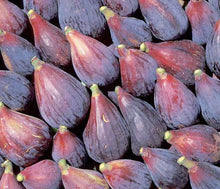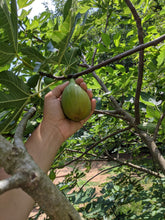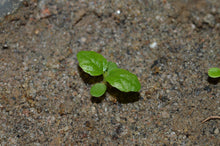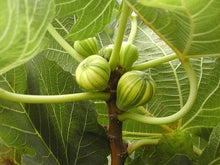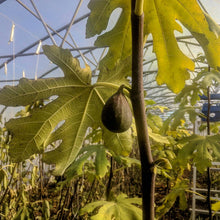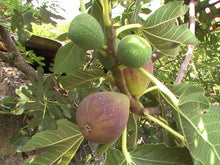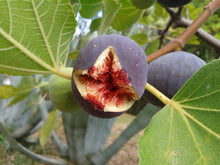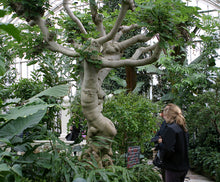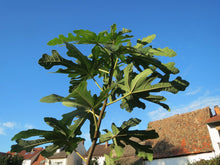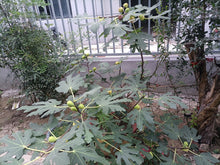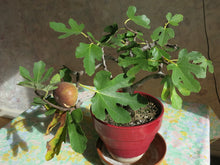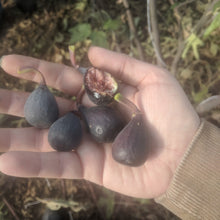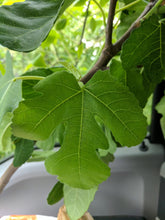Fig
Regular price
$4.00
Sale
Ficus carica
Origin: Pakistan
Improvement status: Cultivated
Seeds per packet: ~100
BOTANICAL SAMPLE - NOT GERMINATION TESTED
Life cycle: Perennial
From the fig-leaf underwear sported by Adam and Eve in the Garden of Eden to the chewy Fig Newtons found in the snack aisle of every supermarket, figs are quite simply iconic. If you've never had a fresh juicy fig, practically falling off the tree, dripping with sweet viscous juice, you haven't tried a real fig. Figs are best enjoyed fresh, but of course most widely enjoyed dried, since they don't transport well once ripe (sadly, most fresh figs sold in supermarkets are underripe and taste terrible). This legendary Mediterranean plant, beloved around the world, is usually propagated by cuttings, yielding genetic clones of the parent plant. This is how popular varieties like 'Chicago Hardy,' 'Celeste,' and 'Brown Turkey' make the rounds. But by planting true fig seeds, you can breed your own new fig varieties, adapted to your own patch of ground.
Figs are of course grown for their fruit, but the fig leaf is far more than just a symbol. It has a long history of use as a food and flavoring too. The leaves are described as having a taste with vanilla, coconut, and (predictably) fig undertones, it is made into tea, added to soups or stews, and used much like grape leaves to wrap freshly prepared foods like rice, vegetables and fish, or preserved foods like fig paste or even cheese. There's even a company in the US using dried fig leaves as a flavoring in kombucha. The fig plant also has a history of medicinal use, with the latex used against warts and calluses, and to deter parasites, and a syrup from figs combined with senna for use as a laxative. Exposure on the skin to fig latex, or even just fresh fig leaves for some more sensitive people, can lead to photodermatitis — similar to parsnips, hogweed, rue and citrus — a painful rash that appears after a patch of skin exposed to the plant juice is exposed to the sun.
Figs can be found growing in climates far colder than their Mediterranean home, and people who love them often go to great lengths to keep them alive in the face of extreme cold-snaps that can cause fig trees to die back to the ground or even die completely. Some people plant them in large pots and wheel them into a garage or barn for the winter. Others wrap them up in burlap, bubble wrap and/or plastic tarps, to protect them from the worst of winter's chill. Still others get even more creative, digging a tree-sized ditch next to their tree, then severing half of the root system and halfway digging-up the whole tree before laying it on its side and burying it! Such is the love people have for their homegrown figs. However, as the climate warms, many fig growers in temperate areas no longer bother with such measures, and in most years they don't need to.
It's become a widespread belief of late that "all figs contain a dead, decomposing wasp." While there is a bit of truth to this — some figs indeed do contain a dead, decomposing wasp — most figs do not. This is because most varieties are self-pollinating, or parthenocarpic, and yield delicious fruit without any wasps to pollinate them. These types of figs are called "persistent" or "common," and cultivars like Black Mission, Brown Turkey, Kadota and Celeste are famous examples of the type. In contrast, "caducous" or "Smyrna" figs, do need to be pollinated by the fig wasp — which has a whackadoo life-cycle you can read all about here — and they also need to be grown in the presence of pollen-producing hermaphroditic fig trees known as "caprifigs" (because they produce non-tasty fruits traditionally fed to goats). Lesser known cultivars like Marabout, Inchàrio, and Zidi are caducous types. Finally, there are "intermediate" or "San Pedro" figs that require no pollination for their first crop of the season (called the "breba" crop), but do need pollination from a caprifig for their main crop. Lampeira, King, and San Pedro are some intermediate cultivars. As you might expect, outside of their native range, farmers mostly grow persistent figs, because the fig wasp isn't around — however, in parts of California, the fig wasp has managed to become established.
Our seed comes from fig trees in Pakistan, imported by the good folks at Sheffield's Seeds in Locke, NY. By planting from seed, you might get any of the types of fig mentioned above: persistent, caducous, intermediate, or caprifig. Please let us know how these do for you!
GROWING TIPS: Figs are quite easy to start from seeds, though they have a thin protective coating that slows germination (it takes about two weeks to break down once planted), so soaking fig seeds for a few minutes in a standard 3% hydrogen peroxide solution helps speed up the process. Plant them in any sterile growing medium, like a peat-based seed starting mix, and add a bit of fertilizer once seedlings are a few weeks old (if your medium doesn't already include some). Plant seeds 1/4 to 1/2 inch deep, and don't allow the seeds or young seedlings to dry out. You might consider a humidity tent or other cover to keep moisture in. Once you have a healthy young plant, pot it up or plant it in its permanent location — sunny and well-drained is best.
NOTE: Photos are all public domain images of figs — or photos taken by Nate. They don't depict figs that came from these seeds. We have no idea what kind of figs these will yield.














